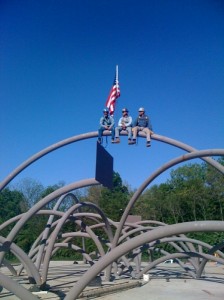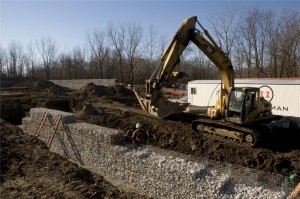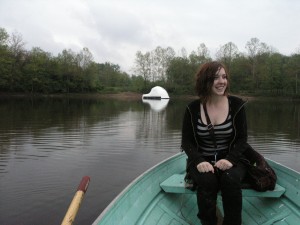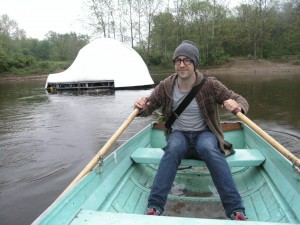This Sunday, 100 Acres: The Virginia B. Fairbanks Art & Nature Park officially opens to the public. There’s a whole weekend of events scheduled. The one I’m looking forward to is the Artist’s Forum this Saturday where we’ll hear from the park artists and architects (the forum will be emceed by writer and celebrity vlogger John Green—represent, Nerdfighters!).
Of recent there’s been a lot published about our new park in newspapers and magazines. While those stories are interesting (and filled with a fair amount of inaccuracies), I’ve been just as intrigued by the many IMA images that have been shared by IMA staffers via Twitter and/or Facebook accounts.

Twitpic by @MaxAndersonUSA of steel workers atop Free Basket
So now that we are so close to the opening, I’ve been looking back through the information that has been shared or created by IMA staff around the artists and projects. And because I’m the conservator charged with caring for these artworks, I can’t help but consider how this information will figure into the IMA’s archives and affect how we understand and represent these projects through the coming years.
A few years ago, we wouldn’t have been able to hear so much from so many different people. Take, for example, the Los Carpinteros project, Free Basket. Now you can not only hear some personal anecdotes directly from the artists in this In The Factory video but you can also hear from a lot of other folks that had a hand in its creation.
100 Acres Project Manager, Dave Hunt describes the early construction stages of Free Basket:
[youtube:https://www.youtube.com/watch?v=F4cLmGgtZYE]
Indianapolis stealworker Tom Williams talks about his role in the project:
[youtube:https://www.youtube.com/watch?v=GyjbDQSzEhU]
While those videos concentrate on the construction process of that project, Alfredo Jaar provided a thoughtful look into his creative process back when his project was still in the proposal stages.
Once Alfredo’s project The Park of the Laments was underway, the IMA’s most well-read blogger, Irvin Etienne, provided a two-part post about his involvement in planting the landscape designed around the space: The Art of Planting–Part One / The Art of Planting–Part Two

The Park of the Laments under construction. Photo from www.imamuseum.org
One of the projects with which I’ve been most involved is Andrea Zittel’s Indianapolis Island. The astute reader of this blog will remember that I interviewed Andrea about the island last winter here on Art21. Now you can also hear from the Barnacle Bros as they talk about their studio and how the fabricated the island in Los Angeles.
Just this week, Michael Runge and Jessica Dunn took up residency out on the water. Not surprisingly they have a blog and Twitter account that allows you to follow their project, Give and Take. I’m looking forward to visiting the island giving them a present and and maybe trying out their bicycle generator.

Jessica Dunn. Photo from Give and Take Blog.

Michael Runge. Photo from Give and Take Blog.
These are just three of the eight projects that will be open this weekend. Of course, the other five installations have a similar amount of documentary information around them. There’s also lots about the new building in 100 Acres, and all of the aspects of nature, including the birds and bees.
Sure, you could look at creating and sharing this information simply as marketing ploy (including this very blog post). Clearly, that’s part of the idea, but not the meat of it. And perhaps it’s because I’m a total homer for 100 Acres, but I think that creating and sharing it provides a variety of honest perspectives for visitors (in person or otherwise) and at the same time is beneficial to the IMA archives. We’ll add this documentation to all of that which hasn’t been shared with the public. In the end, having greater clarity about just about every aspect of 100 Acres will be a benefit to our conservation efforts. The difficulty comes now in its organization, interpretation, and preservation (yes, preserving the documentation that helps to preserve the artworks).
The fundamental difference between this park and others is that none of these projects are meant to be permanent. They’re all temporary and specific to this location. While some appear more permanent than others, it’s possible that in the future all that will left of a project is the documentation that was created and stored at the IMA. This imbues another level of importance to the documentary information.
The question that I’ve been turning around for awhile is about the documentation that will be made by visitors to the park. Should that become part of the IMA archive? In what ways do the visitor’s interactions with a site-specific installation relate to how we understand its representation?



